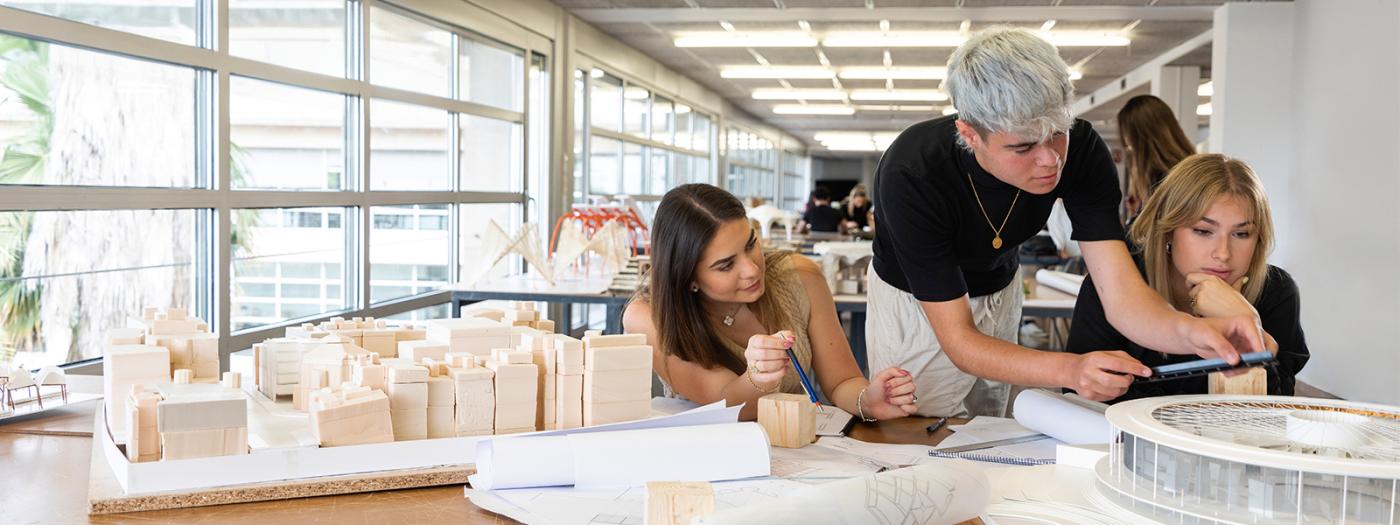Titular Professors
Professors
There is no necessary knoledge
Adequate knowledge of the different technologies.
2D CAD Representation systems
Multi-scale printing
3D CAD basic modelling systems
Off-line / on-line rendering systems
Photomontage and composition basic tools
AR/VR Representation systems
2D workspace
2D drawing systems
2D modification tools
Basic blocks
Dynamic blocks
2D layout
Dimensions
3D workspace
Basic 3D tools
Boolean operations
Basic operations with 3D solids
Basic systems of work plane
Complex operations with 3D solids
Working with meshes and 3D surfaces
3D layout
Cameras and saved views
Render AutoCAD, off-line and on-line systems
Illumination
Practical methodology. 1 class of 1 hour a week of theory where the basic tools and their application to 2D and 3D architectural representation with practical exercises are explained. There are also 2 hours of internships where more complex long-term internships are developed in groups. Both theoretical and practical classes with computer per person and project-oriented representation work.
The subject has two differentiated blocks, the average is made of the grade of each part, higher of equal to 4: 2D (60%) and 3D (40%).
Each block has the same evaluation structure:
A) 20% Continuous assessment on Theory, made of the average of attendance and the average grade of class exercises, being required a minimum of 80% of attendance. (Individual work). Moderately important academic activity.
B) 40% Average grade of practice. This must be higher or equal to 4 so the average with the exam and the continuous evaluation can be made. The breakdown of the grade is updated annually in estudy, as well as the calendar. (Made of individual and group exercises). However, the general breakdown is the same in both blocks (2D and 3D):
20% Practice attendance (individual grade). Moderately important academic activity.
20% Blog updating with theory and/or practice posts (individual grade). Moderately important academic activity.
60% Average of the practice deliveries (group or individual grade according to the type of delivery). Non submitted deliveries will get a grade of 0 if they are not highly important academic activity or an NP in case that they are highly important academic activity (last two deliveries of each semestre are activities categorized as Highly Important Academic Activities. Non-submitting a highly important academic activity implies an NP on the total grade of practice, making it not possible to make the average grade with the exam. (Final semestre grade and global grade of NP).
C) 40% Final exam grade. This grade must be higher or equal to 4 to make the average with the practice and the continuous assessment marks. (Individual work). In case of not submitting the exam, the student will get an NP on it and will need to retake this part in the extraordinary call with a minimum grade of 7. Highly important academic activity.
FINAL ASSESSMENT:
Students with a grade lower than 4 in the 2D must go to the 2D extraordinary call.
Students with a grade between 4 and 4.9 in 2D, will depend on the 3D final grade to be able to pass the subject, if the average is higher o equal to 5 the subject is passed, if the average is lower than 5 the student must go to the extraordinary call of any of the failed parts.
Students with more than 5 on the 2D grade, have passed this part, in the case of retaking the subject and if the 2D exams average is higher or equal to 5, the theory grade is saved 1 year (only the practice part needs to be done, which is not going to be saved).
Students with a grade lower than 4 in the 3D must go to the 3D extraordinary call.
Students with a grade between 4 and 4.9 in 3D, will depend on the 2D final grade to be able to pass the subject, if the average is higher o equal to 5 the subject is passed, if the average is lower than 5 the student must go to the extraordinary call of any of the failed parts.
Students with a grade higher or equal to 5 in the 3D, have passed this part, in the case of retaking the subject and if the 3D exams average is higher or equal to 5, the theory grade is saved 1 year (only the practice part needs to be done, which is not going to be saved).
Students with a block (2D and / or 3D), with a final grade of NP, need a 7 as a minimum grade to average in the extraordinary recall.
The extraordinary recall allows to recover the exam grade and / or the practice grade, being in this last case necessary to elaborate a new individual project in all its phases (2D and 3D).
In case of copy in practice and / or exam, the existing regulations of the School will be applied, integrating the result in the scoring system of the subject.
Optimum Progress (4-3): The student reflects the technical aspects explained in the theory classes and uses optimally the tools and techniques indicated in individual exercises
Adequate progress (3-2): The student uses adequately the techniques and systems explained, with non-relevant errors and / or with a lack of minimum time to finish the proposals
Fair or slightly deficient progress (2-1): The student tries to use the techniques explained, but makes mistakes that affect the final quality and the completion of the exercise
Insufficient progress (1-0): The student does not use the techniques explained, which impacts the rhythm of the exercise, which does not end and / or has serious errors
AutoCAD User Manual. Autodesk, Inc. (on-line)
AutoCAD User Reference. Autodesk Ag. (on-line)
Jonson, N. AutoCAD: Reference Manual. McGraw-Hill.
López, J. Advanced AutoCAD. McGraw-Hill.
Access to download websites for the applications used during the course:
AUTOCAD: https://www.autodesk.com/education/edu-software
LUMION: https://www.lumion.es/estudiantes/
